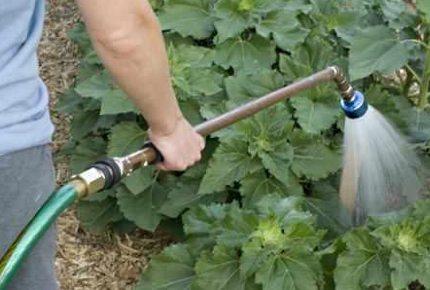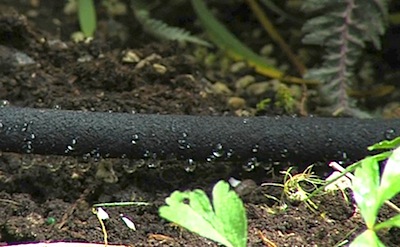Wise Watering Ways
By Angela Sakran, Fairfax Master Gardener
We’ve all done it: realized too late that we’ve either let a plant suffer from lack of water or killed it with too much drink. The key to successful watering is knowing where that “just right” point lies and knowing how best to get water where the plant needs it most.
One amount, method doesn’t fit all
Ideally, it would be great if our gardens could be watered by rainwater alone. But if the rain doesn’t come, you should supplement with irrigation, adding about one inch of water once each week. New and young plants especially require this moisture in the beginning, while they are establishing roots. Dry conditions cause shallow root growth, which, in the long term, affect plant health; shallow roots can’t support the plant or reach needed moisture in the soil.

Wand attachment for gentle overhead watering
The method you use to water your garden is just as important as how much you water. Most gardeners use either overhead watering (such as from a portable lawn sprinkler or garden hose); or drip or trickle irrigation (such as from soaker hoses or thin-wall, drip-irrigation tapes). When using overhead watering methods, adjust the flow rate to about ¾ to one inch per hour. Any faster, and you’ll lose much of your water to run-off, as most soils cannot absorb a lot of water in a short amount of time. Also, move the sprinkler frequently, partially overlapping with each move. This ensures that the sprinkler gives your garden full, even coverage. If you are adding water to your soil using a hose, always use a spray attachment that resembles a showerhead—never a pistol-grip spray nozzle with its harsh stream. Apply water gently to the roots, bypassing the leaves as much as possible. Although popular, overhead watering methods are least desirable, as the water only penetrates the top inch of soil, which can encourage shallow root growth.

Water seeps out of a black soaker hose slowly
No matter what method you use, irrigate in early morning. Irrigate later and you lose much to evaporation, leaving your plants high and dry. Never irrigate at night. This creates a moist environment hospitable to disease.
Mulch to keep moisture in
Mulching helps reduce the amount of water your soil needs by preventing, or slowing down, evaporation. Two to three inches of organic mulch should do the trick. Mulching also keeps weeds at bay. Not only are weeds aesthetically undesirable, they force plants to compete for available moisture in the soil. Applying organic mulch around established bushes, where amending soil is not an option, helps them conserve soil moisture, while also enriching the soil over time through decomposition. Finally, mulch helps to moderate soil temperature, helping your garden use water more effectively.
Lawn rules
When watering your lawn, all the same rules discussed above apply. But remember two other important facts to improve your lawn’s drought tolerance: First, when mowing, do not remove more than a third of the height of the grass. The remaining length in the blades of grass helps to shade the soil, thereby reducing evaporation. Grass with a little length also develops deeper roots that are more efficient at using soil moisture. Second, fertilizing helps to build a strong healthy lawn that doesn’t allow weeds to take over, thus eliminating competition for water.
Soil matters!
You can’t talk about the whys of watering without understanding soil structure. The two go hand-in-hand.
Here’s how it works. Roots absorb water in the soil and send it for use in other parts of the plant. Roots also get oxygen from soil, where it is trapped in little air pockets called pores. Pores exist between the particles of mineral and organic matter that make up soil. Too much water, and these pores fill completely with water and suffocate your plant; too little, and your plant withers and starts to die. Pore size depends on the type of soil you have. Clay soil has tiny pores. For this reason, they drain slowly, and roots can start to suffocate. Sandy soils contain large pores that drain very fast, causing plants to wilt more quickly.
Amending your soil with organic matter is the best step you can take to maintain the moisture balance vital to healthy plants. Most of us have soils that are naturally more clay or more sand. In clay soils, organic matter lightens the soil, thus creating larger pore spaces through which water can drain. In sandy soils, organic matter helps create smaller pore spaces that will hold more water. Keeping a bag of organic matter, or compost, on hand to work into your soil will always help conserve moisture.
Resources
Help Sheets: Watering, The Young Virginia Gardener Program, Department of Horticulture, Virginia Tech
Irrigating the Home Garden, R. Allen Straw, Virginia Cooperative Extension Publication 426-322
Summer Lawn Management: Watering the Lawn, Virginia Cooperative Extension Publication 430-010
Creating a Water Wise Landscape, Virginia Cooperative Extension Publication 426-713